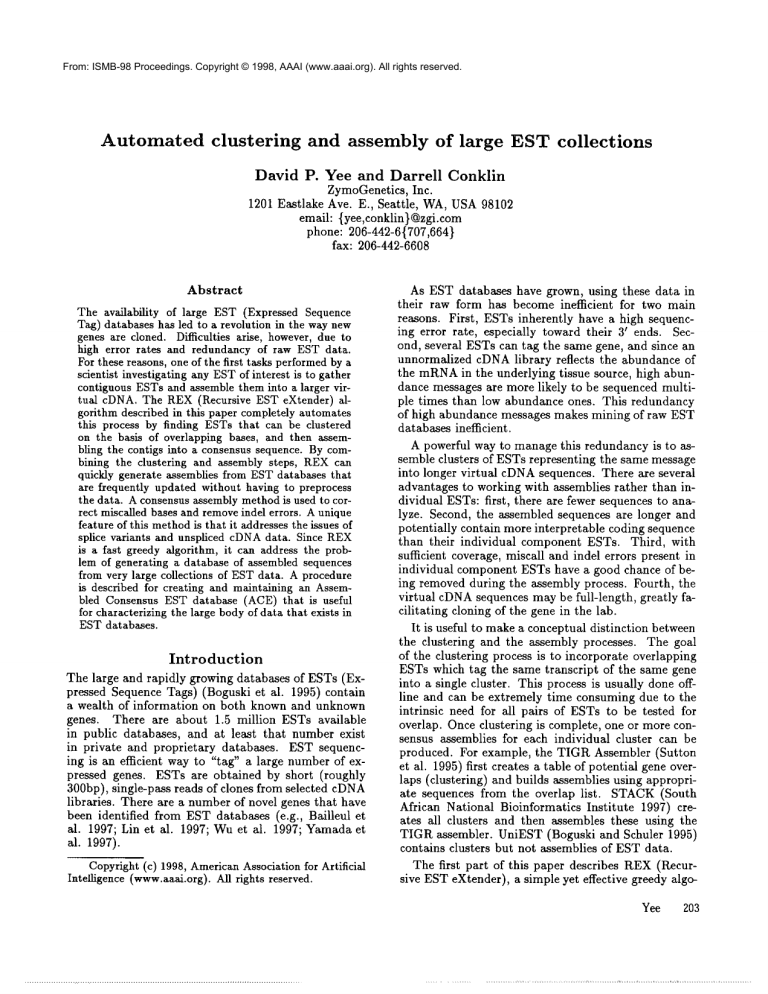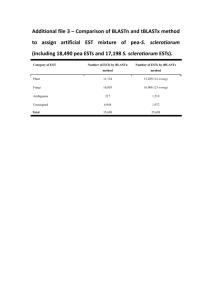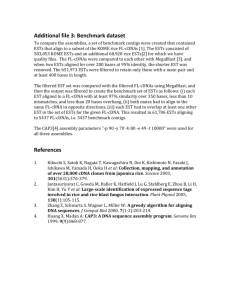
From: ISMB-98 Proceedings. Copyright © 1998, AAAI (www.aaai.org). All rights reserved.
Automated clustering
and assembly of large
EST collections
David
P. Yee and Darrell
Conklin
ZymoGenetics, Inc.
1201 Eastlake Ave. E., Seattle, WA,USA98102
emaih {yee,conklin}@zgi.com
phone: 206-442-6{707,664}
fax: 206-442-6608
Abstract
The avMlability of large EST(Expressed Sequence
Tag) databases has led to a revolution in the waynew
genes are cloned. Difficulties arise, however,due to
high error rates and redundancy of raw ESTdata.
For these reasons, one of the first tasks performedby a
scientist investigating any ESTof interest is to gather
contiguous ESTsand assemble them into a larger virtuai cDNA.The REX(Recursive ESTextender) algorithm described in this paper completely automates
this process by finding ESTsthat can be clustered
on the basis of overlapping bases, and then assembhng the contigs into a consensus sequence. By combining the clustering and assembly steps, REXcan
quickly generate assemblies from ESTdatabases that
are frequently updated without having to preprocess
the data. A consensus assemblymethodis used to correct miscalled bases and removeindel errors. A unique
feature of this methodis that it addressesthe issues of
splice variants and unspliced cDNAdata. Since REX
is a fast greedy algorithm, it can address the problem of generating a database of assembled sequences
from very large collections of ESTdata. A procedure
is described for creating and maintaining an Assembled Consensus ESTdatabase (ACE) that is useful
for characterizing the large bodyof data that exists in
ESTdatabases.
Introduction
The large and rapidly growing databases of ESTs (Expressed Sequence Tags) (Boguski et al. 1995) contain
a wealth of information on both known and unknown
genes. There are about 1.5 million ESTs available
in public databases, and at least that number exist
in private and proprietary databases. EST sequencing is an efficient way to "tag" a large number of expressed genes. ESTs are obtained by short (roughly
300bp), single-pass reads of clones from selected eDNA
libraries. There are a number of novel genes that have
been identified from ESTdatabases (e.g., Bailleul et
al. 1997; Lin et al. 1997; Wuet al. 1997; Yamadaet
al. 1997).
Copyright(c) 1998, AmericanAssociation for Artificial
Intelligence (www.aaai.org).All rights reserved.
As EST databases have grown, using these data in
their raw form has become inefficient for two main
reasons. First, ESTs inherently have a high sequencing error rate, especially toward their 3’ ends. Second, several ESTs can tag the same gene, and since an
unnormalized cDNAlibrary reflects the abundance of
the mRNA
in the underlying tissue source, high abundance messages are more likely to be sequenced multiple times than low abundance ones. This redundancy
of high abundance messages makes mining of raw EST
databases inefficient.
A powerful way to manage this redundancy is to assemble clusters of ESTs representing the same message
into longer virtual cDNAsequences. There axe several
advantages to working with assemblies rather than individual ESTs: first, there are fewer sequences to analyze. Second, the assembled sequences are longer and
potentially contain more interpretable coding sequence
than their individual component ESTs. Third, with
sufficient coverage, miscall and indel errors present in
individual component ESTs have a good chance of being removed during the assembly process. Fourth, the
virtual cDNAsequences maybe full-length, greatly facilitating cloning of the gene in the lab.
It is useful to makea conceptual distinction between
the clustering and the assembly processes. The goal
of the clustering process is to incorporate overlapping
ESTs which tag the same transcript of the same gene
into a single cluster. This process is usually done offline and can be extremely time consuming due to the
intrinsic need for all pairs of ESTs to be tested for
overlap. Once clustering is complete, one or more consensus assemblies for each individual cluster can be
produced. For example, the TIGR Assembler (Sutton
et al. 1995) first creates a table of potential gene overlaps (clustering) and builds assemblies using appropriate sequences from the overlap list. STACK(South
African National Bioinformatics Institute 1997) creates all clusters and then assembles these using the
TIGR assembler. UniEST (Boguski and Schuler 1995)
contains clusters but not assemblies of ESTdata.
The first part of this paper describes REX(Recursive ESTeXtender), a simple yet effective greedy algoYee 203
rithm which completely integrates the clustering and
assembly steps for EST data. It generates an assembly concurrently with the clustering process. A major
feature of REXis the ability to rapidly generate assemblies from an arbitrary set of EST databases without
the need to preprocess the data.
The second part of this paper describes a process for
managing and maintaining large numbers of EST assemblies generated by the REXalgorithm described in
the first section. Creating a database of fully assembled ESTs requires an enormous amount of computer
time. The process described in this paper allows the assembled database to be updated as new data becomes
available. This alleviates the need to completely redo
the assembly computation and ensures that the assembled database is kept current. Finally, a unique feature
of this methodis that it specifically recognizes and addresses the problems of splice variant and unspliced
eDNAdata, in that multiple assemblies for the same
gene may be created.
The REX algorithm
The REXalgorithm is a simple yet effective algorithm
which integrates the clustering and assembly steps necessary to create a consensus assembled sequence from
ESTdata. It is fast and reflects an intuitive idea of
extending an anchor sequence in the 51 to the 3~ direction with ESTs derived from an arbitrary number
of sequence databases. A rough assembled sequence is
created in the process of extending an anchor. This
rough assembly is then improved by analyzing a multiple alignment of contigs to make consensus base calls
and to remove potential insertion and deletion errors.
After this work was completed we became aware of
the GAPsystem (Gill et al. 1997), which describes
interface for interactive ESTassembly in which a scientist can probe a database for ESTs to extend a current
consensus assembly. The iterative process is entirely
manual, and constructing a single assembly could be a
time consumingexercise for the scientist, particularly
if the assembled sequence is long. REXcompletely automates the clustering and assembly of a virtual eDNA
sequence using a single specified sequence as an anchor.
Contigs
Given an anchor sequence, REXfinds contiguous ESTs
(contigs) by using blastn (i.e., ungappedlocal alignment, X=5, W=16, E=le-15, Z=5e+8, Y=300, M=5,
N=-4) (Altschul et al. 1990) on one or more
databases using the anchor sequence as a query. The
Y and Z parameters are set in order to normalize the
blastn expectation values between different database
sizes and anchor sequence lengths. This set of parameters requires approximately a 70 base pair overlap
between two ESTs. It was determined that these parameters are sufficiently liberal to accommodateEST
sequencing errors, and also that roughly 95%of all human paralogous gene families will be separated (data
204 ISMB-98
not shown). (The ortholog issue is easily addressed
by using species-specific ESTdatabases). In problematic cases, where two different genes are equivocated,
the stringency of overlap can be adjusted with the E
(blastn expectation value) parameter.
During the blastn process, an anchor sequence is
maskedusing a very fast sequence filter which replaces
vector sequences, ALU,LINE, and other repetitive elements (including stretches of 30 or more identical
bases) by the base "N’. These masked regions will
therefore never be used to identify contiguous ESTs.
All reported blastn hits using the parameters given
above are considered to be contigs; these contigs are
retained in a list for later use by the consensus assembly process (described below). Contigs which extend
the anchor in the 3’ direction are considered for use as
anchors for recursive extension. REXis a greedy algorithm, choosing only one contig to extend an anchor
sequence. Below the algorithm is described, then the
procedure for choosing the extender contig is explained
in detail.
Building
an extended sequence
Figure 1 illustrates the REXalgorithm. First, all extender contigs to an anchor sequence are gathered. An
extender contig is any contig which extends the anchor sequence in the 3~ direction. The coordinates
of the Maximum-scoring Segment Pair (MSP) (i.e.,
the highest-scoring blastn High-scoring Segment Pair
(HSP) or ungapped local alignment) fix the alignment
with the chosen extender contig. The appropriate segment (sequence fragment f in Figure 1) is cut out of the
extender contig, and that segment is used recursively
as an anchor. If the extender contig is in the minus
strand, the segment is reverse complemented before
being used as a recursive anchor. The recursion ends
when no extender contig can be found. The details of
how to modify the MSPcoordinates for a minus strand
contig have been omitted.
A slight distinction is made in REXbetween an anchor sequence encountered during recursive extension
and the "top-level" anchor sequence specified by a user
or calling process. The distinction is that the top level
anchor sequence must be extended in both the 3~ and
the 5’ directions. To accomplish this, the anchor is extended: next, the reverse complementof the anchor is
extended. To preserve the orientation of the original
anchor sequence, the reverse complement of the second result is taken and the results of the 51 and the
3’ extensions are spliced together to produce the final
extended sequence (see Figure 1).
Note that the algorithm does not actually build the
assembly until it starts to unwind from the recursion.
This means that only single ESTs, rather than complete assemblies as in the TIGRand GAPassemblers,
are used to gather contigs. The time taken by the REX
algorithm to assemble a virtual eDNAis primarily dependent on the number of recursive extension steps
q!
5’
A (anchor)
MSP
5’
S
3s
(plus strand contig)
A’ (minus strand contig)
3’
5’
s
5
s
3
f (recursive
anchor)
/* extend an anchor sequence A */
rex(A)
if A has no extender contigs, return A
else
let A’ be the chosen extender contig to A
let (q,s) be the left coordinates of their MSP
let f be the sequence fragment A’[s...length(A’)]
if A’ is a minus strand contig, return
A[1...q-1] + rex(revcomp(f))
/* recursion */
else return
A[1...q-1] + rex(f)
/* rec~rsion */
/* extend the top-level anchor sequence A */
let r be the sequence rex(A)
let 1 be the sequence revcomp(rex(revcomp(r[i...length(A)])))
return 1 + r[length(A)+1...length(r)]
Figure 1: The REXalgorithm. S[z...y] denotes the substring of S from index x through y. + in a string context
represents string concatenation.
Yee 205
needed (i.e., the numberof blastn runs) and is otherwise independent of the length of the assembly. The
TIGRassembler, on the other hand, iteratively merges
similar fragments to a growing current assembly using
the Smith-Watermanalgorithm and it presupposes the
existence of a precomputedtable of pairwise ESToverlaps.
Choosing an extender
contig
If all mRNAtranscripts
derived from the same gene
were identical it would be irrelevant which extender
contig was chosen since (aside from error-laden ESTs)
roughly the same virtual cDNAwill be computed by
the REXalgorithm. Two complications with ESTs,
however, are that they can be derived from alternatively spliced mRNA
and unspliced (intron containing)
hnRNA (Wolfsberg and Landsman 1997). REX does
not choose ESTs which appear to be unspliced or alternatively spliced in relation to the anchor sequence. To
check for alternatively spliced ESTs,it is required that
the quantity (q’ - q) - (s’ - s), is in a narrow interval
(see Figure 2: bottom). To check for unspliced ESTs,
the maximumpossible overlap between the extender
and anchor (see Figure 2: top) is computed based
the coordinates of the MSP.The summedlength of all
consistent HSPs is required to cover a minimumpercentage of this region. In practice it is not possible to
distinguish between unspliced and alternatively spliced
messages in short EST data. Consequently, REXcan
only recognize that an ESTmay fall into one of these
categories. All such ESTs are flagged by the REXalgorithm and are not chosen as extender contigs for this
particular run.
There are several modes for choosing one out of
many possible consistent extender contigs. The first
mode chooses the extender contig with the maximum
percent identity when averaged over all consistent
HSPs. In the second mode, the extender contig which
extends the sequence the furthest 3t is chosen. The
second modeis usually faster since fewer recursive extension steps generally need to be performed. It is also
possible to choose the extender contig with the most
coverage of the potential overlap region.
Consensus
assembly
REXdiffers from other assembly methods in the way
the final consensus assembly is created. The TIGRassembler (Sutton et al. 1995), for example, represents
rough assembly as a frequency profile from which consensus base calling is performed. REXrepresents the
rough assembly as a single extended sequence which is
a composite of fragments from extender contigs used
during the extension process. As a result, sequencing errors in these individual fragments will also be in
the rough assembly. To correct sequencing errors, a
consensus assembly is created by aligning the blastn2
(i.e., gapped local alignment, parameters as above for
blastn, with Q=14) MSPof all contigs (which were
206
ISMB-98
gathered during the extension process) with the rough
assembly. This provides a full multiple alignment of all
contigs. A frequency profile is built for every column
of this multiple alignment, and consensus base calls are
made using a set of rules similar to those used by the
TIGRassembler (Sutton et al. 1995). In addition,
use a novel rule which handles commonbase expansion
errors as often encountered in ESTdata. This automated procedure for consensus assembly can lead to
the correction of both base call errors and indels in the
rough assembly.
As the consensus sequence is built, a map showing
the location of all contigs in the assemblyis developed.
Figure 3 shows an example of an Assembled Consensus
ESTdatabase entry (described in the next section).
The section of the figure labeled "REXMAPFILE"
shows a contig map generated by REX. ESTs which
were used as left and right extenders are marked with
<* or >* respectively. The top-level anchor is marked
with ***. The percent identity between the rough assembly and the contig in the region of the MSPis indicated in the next column, l%egions of a contig which
are not contained in the MSPare indicated with dots.
A dotted region mayrepresent a piece of unspliced hnRNA(i.e., intron), a splice variant, a maskedrepetitive
element, or simply poor, error-laden sequence. Following this are the query coordinates of the MSP, and
in brackets the name of the ESTclone partner, when
available. Whenboth the 3~ and 5p ESTs of a clone
pair are included in an assembly, the ESTidentifiers
are marked with an asterisk.
Figure 3 also displays the assembled sequence which
is identical to the Placentin gene (Genbank accession
L34838). Translation of the assembled sequence for
this exampleyields a sequence that is free of indels, despite the fact that all individual contigs have indel errors and some contigs appear to derive from unspliced
hnRNA.In fact, there is an average of 6 indels per EST
in the cluster. The TIGRassembler produces 5 THCs
(Tentative HumanConsensus sequence) for this gene.
All but one (THC155875,one indel) have several indel
errors. Another (THC207858)appears to be a chimeric
assembly (composed of two distinct messages).
The exampleabove is for illustration only and a full
description and evaluation of the REXassembly and
consensus base calling method will appear elsewhere.
ACE: Assembled
Consensus
ESTs
There are about 1.5 million ESTs available in public
databases. Manyquestions concerning these data come
to mind. Howmany of the approximately 100,000 human genes do these ESTs represent? Are all human
genes "tagged" in existing EST databases? If not,
how far away are EST databases from complete coverage? Which ESTs represent highly expressed messages? Which ESTs represent rare messages? What
proportion of ESTs represent mis-spliced messages?
Howmany splice variants are observed for an typi-
5’
I
q
(anchor)
MSP
5’
s
i
(maximum possible overlap)
5’
q
(anchor)
MSP
5’ s
Figure 2: Identification
of possible anomalous ESTs. Top: the HSPs between the anchor and extender contig do
not cover enough of the possible overlap region. This contig may derive from hnRNA(heteronuclear, unspliced
RNA)or alternatively spliced mRNA.Bottom: an HSPis inconsistent with the MSP. This contig probably derives
from an alternatively
spliced mRNA.
cal gene? One way to address these questions is to
construct a fully assembled ESTdatabase.
In this section, our effort to apply REXsystematically to a large collection of ESTsin order to represent
every ESTin at least one cluster is described. REX
is well suited for creating an assembled ESTdatabase
since it is highly amenable to non-interactive, automated batch processing of EST databases. By iteratively running REXwith anchor sequences selected
from a database of EST sequences, it is possible to
create an assembled database, which is called ACEfor
Assembled Consensus ESTs.
ACEis constructed by iteratively selecting an anchor
EST from a set of unassembled ESTs. After picking
an anchor, the first step is to determine if the anchor
is contiguous with an existing assembled consensus sequence. If so, the anchor sequence is removed from the
pool of unassembled ESTs and is added to the cluster
of ESTs that is associated with the matching consensus sequence. The consensus sequence is then marked
for update so the assembly will be recalculated using
the original anchor sequence in order to incorporate
the new data.
If the anchor sequence is not contiguous with an existing consensus sequence, then REXis used to produce a cluster of contigs and an assembled consensus
sequence representing the cluster. The new consensus sequence is then compared to the set of existing
ACEconsensus sequences. If an existing ACEsequence
shares 90%sequence identity over 90%of the length of
the new consensus sequence, the shorter of the two sequences is removed and the EST clusters are merged.
All of the contig ESTs contained in either assembly
are removed from the unassembled EST pool. If necessary, the retained cluster is marked for update and
subsequent recalculation.
If the new consensus sequence is not contiguous with
an existing ACEsequence, then it represents either a
novel assembly or a splice variant of an existing assembly. In either case, the new assembly is added to the
set of ACEsequences and the contig ESTs are removed
from the unassembled EST pool. By not considering
any EST that already exists in an ACEassembly as
an anchor sequence, calculation of multiple assemblies
representing the same gene is avoided. The iterative
assemblyprocess is illustrated in Figure 4.
Since an enormous amount of computation time is
required to fully assemble a large ESTdatabase, it is
desirable to both maximize the diversity of the assemblies and to preferentially create "interesting" assemblies first. One way to maximize the diversity of the
assemblies is to initially ignore splice variants. REX
identifies inconsistent ESTs that mayrepresent splice
variants relative to the current assembly. By using
these ESTs as anchor sequences in subsequent REX
runs, it would be possible to calculate several potential splice variants of a given gene. While this is desirable, it is more useful to first maximizethe number
of unique genes in ACEas opposed to initially calculating all possible variants for a smaller set of genes.
Yee 207
;ID ACE_EST1086973
;DT 11-0ct-1997 (CREATED)
;DT 11-0ct-1997
(UPDATED)
;DT 27-Jan-1998 (LAST ANNOTATION
UPDATE)
;CC ASSEMBLED
BY (rex)
;CC
;CC -!- LIBRARIES (instances
(freq)
library
name)
;CC 17 (0.708333)
Soares placenta Nb2HP
;CC 6 (0.250000)
Soares fetal liver spleen 1NFLS
;CC 1 (0.041667)
Soares total fetus Nb2HF8 9w
;CC
;CO -!- REX MAPFILE-!;CC locus
pid 1 ............................................................
763
;CC EST201890
95.00 ......................
. .... > 14-303 (EST201839*)
;CC EST262328
97.60 ......................
. ........
> 14-300 (EST262329*)
;CC EST201933
92.60 .........................
> 14-343 (EST201323*)
;CC EST1086973
**.100.0 ................................
> 1-431
;CC EST252669
95.20
..........
> 25-309 (EST252559*)
;CO EST244553
96.80 .......................
..> 25-331 (EST244554*)
;CC EST362059
97.80
....................
..> 32-300 (EST361244)
;CC EST125542
96.70
........................
> 30-358 (EST125468*)
;CC EST255024
96.90
..........................
. ........
> 28-370 (EST254662,)
;CC EST233419
97.20
..........................
. ........
> 27-372 (EST233579)
;CC EST331976
95.50
............................
. ..... > 40-411
;CC EST238995
93.80
................................
...> 33-446 (EST238891,)
;CC EST497330
95.80
.....................
> 43-329 (EST475577)
;CC EST371834
96.40
............................
> 47-432
;CC EST252559
97.60
< ........
- ...........................
226-589 (EST252669*)
;CC EST201323
96.80
< ...............
- ...................
349-619 (EST201933*)
;CC EST244554
92.60
< ..........
- ......................
313-616 (EST244553*)
;CC EST254662
94.20
< .......
- ..........................
. 254-603 (EST255024,)
;CC EST238891
97.20
<..- ............................
233-616 (EST238995*)
;CC EST262329
96.90
< .......
- .......................
298-619 (EST262328*)
;CC EST125468
93.30
< .....
- ......................
313-618(ESTI25542*)
;CC EST245284
>*96.90
........................
> 310-626(EST245285)
;CC EST253958
>*98.00
..............................
> 364-761
;CC EST201839
97.90
< ..................
377-617(EST201890*)
;CC
;CC - !- ZGI ANNOTATEDCOMPONENTESTS - !;CC
Data not shown
;CC
;SQ SEQUENCE763 nucleotides
ACE_EST1086973
ATTCGGCACTAGGGAAGGGACACACCAGCACAGTCTGGTAGGCTACAGCAGCAAGTCTCTAAAGAAAGGC
TGAGAACACCCAGAACAGGAGAGTTCAGGTCCAGGATGGCCAGCCTGTTCCGGTCCTATCTGCCAGCAIT
CTGGCTGCTGCTGAGCCAACTCCTTAGAGAAAGCCTAGCAGCAGAgCTGAGGGGATGTGGTCCCCGATTT
GGAAAACACTTGCTGTCATATTGCCCCATGCCTGAGUGACATTCACCACCACCCCAGGAGGGTGGCTGC
TGGAATCTGGACGtCCCAAAGAAATGGTGTCUCCTnCCAACAACAAAGATGGACAAGCCTTAGGTACGA
CATCAGAATTCATTCCTAATTTGTCACCAGAGCTGAAGAIACCACTGTCTGAAGGGCAGCCATCATTGAA
GAAAATAATACTTTCCCGCAAAAAGAGAAGTGGACGTCACAGATTTGATCCATTCTGTTGTGUGTAATT
TGTGACGATGGAACTTCAGTTAAATTATGTACATAGTAGAGTAATCATGGACTGGACATCTCATCCATTC
TCATATGTATTCTCAATGACAAATTCACTGATGCCCAATTAAATggATtgCTGTTTATTAGGAICATGAG
GAATCATTATTAGGTATTCACATGTTTTCACTTGGCTCnTGTACnTAATTATAGGTCTCTTCCCnAATTG
GGGGGGAGGTTAGGnTAGGnTTGGGGTTTAGGTTCCCGGTAGGTTGnTAGGnTCCAnTGGGGG
Figure 3: An ACE entry representing
the insulin-like
hormone Placentin
(Swiss-Prot
INL4_HUMAN,Genbank
accession
L34838) using dbEST entry EST1086973 as an anchor sequence.
The ACE entry shows the assembly
date, the library distribution
of the contigs, a contig map, and the consensus sequence.
208
ISMB-98
41J
REX assembly
assembly
REX
Pick
Pick aa seed
seed EST
EST from
from
the unassembled
unassembled
EST
the
EST
pool.
pool.
(1) EST matches an
assembly
(2) new assembly is
identical to an
existing assembly
Remove EST
EST from
fr~n pool
pool
−- Remove
Re~ove contig
contig ESTs
mSTs
−- Remove
from pool
pool
from
Delete redundant
redundant
−- Delete
assembly
assembl~
(3) assembly is
novel
Re~ovo contig
contlg ESTs
ESTs
−- Remove
from pool
pool
from
Add new
new assembly
assembly to
to
−- Add
ACE database
database
ACE
J
Pick aa seed
seed EST
EST from
from
Pick
new unassembled
unassembled EST
EST pool
pool
new
Figure 4: ACE assembly process.
The pool of unassembled
ESTs is represented
by shaded ovals.
After picking an
anchor EST from the unassembled
EST pool, (1) the anchor
may be subsumed by an existing
assembly,
(2)
assembly generated
by the anchor may be identical
to an existing
assembly,
or (3) the assembly may be novel.
each of the three cases,
the relevant
ESTs are removed from the unassembled EST pool and the process is repeated.
Yee
209
Consequently, the splice variant information generated
by REXis not explicitly used wheninitially constructing ACE.
More importantly, our aim was to enrich ACEwith
"interesting" assemblies that have a higher than random chance of representing a gene of interest.
One
way to enrich ACE is to select anchor ESTs that
look "interesting".
For example, if one were mining ESTdatabases for novel G-protein coupled receptors (GPCRs), one could search the EST databases
for all ESTs that match a known GPCRabove a low
stringency threshold. All of the potentially interesting
ESTs based on the GPCRhits can then be used as
REXanchor sequences. While some of the assemblies
may represent genes that are not GPCRs(i.e., false
positives), the calculated assemblies are enriched for
GPCR homologs.
ACEis maintained using a relational
database
(SYBASE).The type of information available for every
assembled sequence includes the consensus sequence,
the anchor sequence, the assembly method used, the
organism, and the date of assembly. In addition, all
contig ESTsare represented in a cluster along with information indicating the libraries from which the ESTs
were derived and the orientation and position of the
ESTsin the consensus sequence. Finally, site specific
annotations associated with component ESTs are also
represented in the data model. A fiat file representation of an ACEassembled sequence is shown in Figure 3.
By assembling individual ESTs into consensus sequences, it is possible to generate an improved, less
redundant view of the ESTdata. Specifically, the average length of an assembled sequence is increased relative to an EST; this may yield more interpretable sequence for the purpose of database mining. The sequences may also have fewer errors due to the consensus assembly method used by REX. Finally, there
are fewer sequences in an assembled EST database to
search relative to a database consisting of all component ESTs. If a gene is sufficiently represented by EST
data, full-length virtual transcripts can be created by
this process.
The relational database representation of the ACE
data allows one to make complex queries of the data.
By monitoring the libraries from which the component
ESTs in each assembly were derived, it is possible to
calculate tissue distribution information (i.e., an electronic Northern). It is also possible to identify low
information content ESTs by finding those that participate in many ACEassemblies. The identification
of
low information content ESTs was helpful in refining
the repetitive element filter mentioned earlier in this
paper. It is also possible to identify rarely expressed
messages by looking for assemblies that have few ESTs
in their clusters.
Another useful feature of ACEis the ability to measure the novelty of new EST data. After creating a
210 ISMB-98
assembly from a new EST, the resulting consensus sequence can be new, a splice variant, or identical to an
existing assembly. By monitoring the ratio of novel assemblies to redundant ones, it is possible to determine
howeffectively novel data is generated by a given sequencing strategy.
Discussion
The sequence assembly problem has long been known
to be intractable due to the large space that must be
searched to produce optimal solutions. However, faced
with a large body of vMuable EST data one needs to
address the assembly problem. Efforts such as those
of TIGR(Sutton et al. 1995) have been valuable
supplying the scientific communitywith a second generation database of assemblies. This paper has described the REXalgorithm, a simple greedy assembly
algorithm which is an alternative to tools such as the
TIGR assembler and others which precompute a table
of all pairwise overlaps. Since no preprocessing is necessary before generating an assembly, REXis particularly amenable to databases that are changing rapidly.
It is a greedy algorithm because as it "walks"
through a database of ESTs creating a virtual cDNA,
it chooses without lookahead a single ESTto perform
the extension at each step of recursion. Whenfaced
with an anchor sequence which may be unspliced or
a variant with respect to some other EST, it tries to
create an assembly which represents the same variant
as the anchor EST. Thus for a given gene, different
anchors may produce assemblies of varying length and
content. Also note that there is no guarantee that
the consensus sequence produced by REXactually occurs; for example, the sequence produced by REXmay
mergedifferent parts of two splice variants into a single
assembled sequence.
The ACEdatabase is an example of the systematic application of the REXalgorithm to large EST
databases, analogous to the THC(Tentative Human
Consensus) efforts of the TIGR group (Sutton et al.
1995). Wehave described a process for creating an assembled EST database, and outlined a procedure for
maintaining this database as new data is generated.
Once created, the assembled ESTdatabase can be updated and the full database never has to be recomputed.
As EST databases approach complete coverage of
all expressed humangenes, the ability to characterize
these data becomescritical. By querying a relational
database of fully assembledESTs, it is possible to identify high- and low-information content ESTs, generate full length virtual transcripts, identify ESTsthat
are poorly represented in ESTdatabases, and generate
tissue distribution profiles for well represented genes.
Since REXidentifies ESTs that are potential splice
variants, there is a mechanismfor systematically exploring all splice variants of an expressed gene. ACE
also allows one to assess the novelty of new data. Fi-
nally, by observing changes in the number of assemblies, it is possible to address the question of howmany
expressed genes are represented in ESTdatabases.
Acknowledgments
The authors would like to thank Patrick O’Hara
for providing a stimulating research environment,
DomenickVenezia for keeping the computers alive and
databases current, and Jim Holloway for preliminary
work on the repetitive element sequence filter. Finally,
the authors thank Scott Presnell, Paul Sheppard, and
Terry Farrah for useful commentsand feedback during
the development of REXand ACE.
References
Altschul, S., Gish, W., Miller, W., Myers, E. and Lipman, D. 1990. Basic local alignment search tool. J.
Mol. Biol., 215,403-410.
Bailleul, B., Akerblom,I., and Strosberg, A. D. 1997.
The leptin receptor promoter controls expression of a
distinct second protein. Nucleic Acids Research, 25,
14:2752-2758.
Boguski, M. S., Lowe, T. M., and Tolstoshev, C.
M. 1993. dbEST-database for "Expressed Sequence
Tags". Nature Genetics, 4, 332-333.
Boguski, M. and Schuler, G. 1995. ESTablishing a
Human Transcript Map. Nature Genetics, 10, 369371.
Gill, R., Hodgman,T., Littler, C., Oxer, M., Montgomery, D., Taylor, S. and Sanseau, P. 1997. A new
dynamic tool to perform assembly of Expressed Sequence Tags. CABIOS, 13, 4:453-457.
Lin, J., Poole, J., and Linzer, D. I. 1997. Three
new members of the mouse prolactin/growth hormone
family are homologous to proteins expressed in the
rat. Endocrinology, 138, 12:5541-5549.
South African National Bioinformatics Institute 1997.
STACK: Sequence Tag Alignment and Consensus
Knowledgebase. www.sanbi.ac.za/stack
Sutton, G., White, O., Adams. M. and Kerlavage, A.
1995. TIGR Assembler: A new tool for assembling
large shotgun sequencing projects. GenomeScience
8J Technology, 1, 1:9-19.
Wolfsberg, T. and Landsman, D. 1997. A comparison
of expressed sequence tags (ESTs) to human genomic
sequences. Nucleic Acids Research, 25, 8:1626-1632.
Wu, Z., Wu, J., Jacinto, E., and Karin, M. 1997.
Molecular cloning and characterization
of human
JNKK2,a novel :lun NH2-terminal kinase-specific kinase. Mol. Cell. Biol., 17, 12:7407-7416.
Yamada, Y., Nezu, J., Shimane, M., and ttirata,
Y.
1997. Molecular cloning of a novel vascular endothelial growth factor, VEGF-D.Genornics, 42, 3:483-488.
Yee
211





